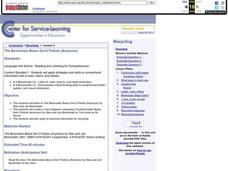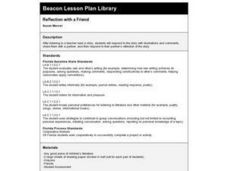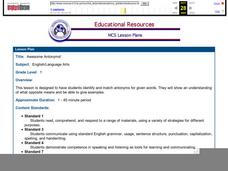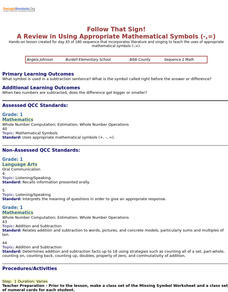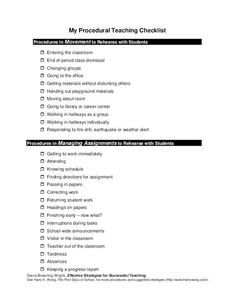Curated OER
Owen
Students read Owen by Kevin Henkes. In this literature lesson, students listen to the story and compare it to other Kevin Henkes books. They answer comprehension questions and bring their own treasured item to share.
Curated OER
Destination Reading
Students practice reading skills and comprehension through the use of computers and the educational software "Destination Reading" provided by Riverdeep in this self-directed lesson plan.
Curated OER
Monitor and Clarify Unknown Words in Corgiville Fair
Students identify unknown words and select a strategy to comprehend text. In this vocabulary lesson students listen for specific words as the teacher reads. Students try to figure out what the meaning of the specific words are. The words...
Curated OER
The Berenstain Bears Don't Pollute (Anymore)
Students listen to the story, The Berenstain Bears Don't Pollute (Anymore). They create a Venn Diagram comparing it with the story, The Lorax. Then students plan ways to become advocates for recycling.
Curated OER
Reflection with a Friend
Young scholars listen to story and respond with illustrations and comments.
Curated OER
Hurricanes Katrina and Rita: Stories To Be Told
Students listen to stories about the tradegies of Hurricane Katrina and Rita. Using their own experiences from the hurricanes, they try to put their own story into words. They are to focusing on getting the information and their feelings...
Curated OER
Animal Actions
First graders act out a story. In this animal actions lesson, 1st graders listen as a story is being read and performs movements to represent the animals described.
Curated OER
Loving to Read While Learning to Express!
Students practice recognizing words more accurately, rapidly and automatically by assessing five major techniques and strategies: reading faster, reading with expression, reading smoother, reading silently, and reading voluntarily. They...
Curated OER
Spelling
Students complete spelling activities. In this online spelling lesson plan, students watch a clip that uses 'ai' words. Students try spelling the words and discuss spelling strategies. Students work in pairs to spell their own names and...
Curated OER
Number Families
First graders examine the relationship between numbers and number families. They listen to the poem "Kangaroo and Toad" by Shel Silverstein and create a list of the largest animals they can think of. Students then order the animals...
Curated OER
Express Your Reading
Students increase their reading fluency and reading expression through the use of various strategies. After reviewing decoding and rereading, students complete an initial read of a novel text without expression. Working with a partner,...
Curated OER
Humpty Dumpty Webquest
Young scholars explore and dramatize the nursery rhyme "Humpty Dumpty." They explore a variety of nursery rhyme websites, and listen to, dramatize, and recite Humpty Dumpty. Students also answer comprehension questions and sequence the...
Curated OER
Ready, Set, Read
Learners increase their reading fluency through the use of various strategies. After reviewing chunking and rereading, students complete an initial read of a novel text. They record their word count on a progress chart after timed read.
Curated OER
Man on Trial Pre-Reading Activities
Students employ different strategies in order to increase reading comprehension. The Story is used to captivate the learners and provide a link to long term memory. By studying the one text in depth the skills will be embedded in the...
Curated OER
Talk to Mom, Dad, Sister Worksheets
Help learners with special needs recognize the interests of their family members and build a foundation for conversation practice using worksheet activities and social prompts.
Lerner Publishing
Teaching Habitats
What makes up a habitat? Use this resource to engage first graders in the exploration of desert, wetland, forest, and ocean habitats. Youngsters classify plants and animals into the four distinct habitats through drawings and cutting and...
Lerner Publishing
Living or Nonliving
It's alive! Or is it? Through a series of shared readings, whole class activities, and independent exercises children explore the difference between living and non-living things, creating a pair of printable books...
Curated OER
Water Fun
Students examine uses for water. In this water lesson, students discuss how they use water. As a class students make a PowerPoint by naming one swimming safety rule. Students compare and contrast fishing for fun and fishing for survival.
Curated OER
Awesome Antonyms
Review with your young learners what opposites are and use a fun tag board game called Auntie Alice to practice. After the class plays the game, pairs work on computers practicing with interactive matching/flashcards/concentration games...
Library of Congress
Stars, Stripes and Symbols of America: Comparing Our Flag, Past and Present
Your young historians will compare and contrast the details of the American flag today with an an image of the nation's flag from the post-Civil War era, and identify the flag's importance as a national symbol through analysis...
Curated OER
“THE LORAX” by Dr. Seuss
Few children's books convey the message of conservation as well as Dr. Seuss' The Lorax. Read the story aloud, emphasizing the interconnectedness of plants and animals in an ecosystem and discussing different ways people can help...
Curated OER
Follow That Sign! A Review in Using Appropriate Mathematical Symbols
Kids gain a deeper understanding of mathematical symbols, by playing an interactive game using flash cards. They complete an attached Missing Symbols Worksheet, flash card and an assessment are also included.
Learner
Solid Shapes
A collection of two lessons, kindergartners will identify two-dimensional shapes in solid shapes. They will develop basic knowledge of the components that make up a sphere, rectangular prism, pyramid, cylinder, cone, and cube. Young...
Positive Environments
My Procedural Teaching Checklist
There are so many details involved in running a classroom! A helpful list addresses each classroom procedure for new students, including changing groups, walking in the hallways, visitors in the classroom, and organizing materials.



